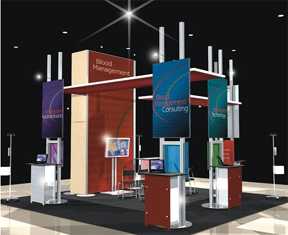 Many businesses are considering exhibiting at trade shows. If you want to taqke home the signed contract, now is the time to start planning how you’ll innovate –and integrate –the trade show experience.
Many businesses are considering exhibiting at trade shows. If you want to taqke home the signed contract, now is the time to start planning how you’ll innovate –and integrate –the trade show experience.
You should be working on ways to:
Make an impression. Your trade show booth needs to be creative, clean, and energetic and it needs to connect with and promote your brand and your message. Make your trade show display let people know who you are, what you do, and what you value. Your trade show booth should be innovative and unique so your customers (and potential customers) will remember you long after they walk away.
Customize your message. Your customers are different from your prospects, so design different conversations for each. Marketers have been creating buyer personas for years, but thanks to big data analytics, it’s now possible to create profiles with greater specificity than ever before. Use these insights to individualize your messages and bolster your appeal. Be sure that message is clear in you trade show booth and in your marketing materials.
Listen. When you’re at a trade show, don’t just sell. Don’t just push. One of the most important things you can do at any event is listen.
Connect before, during and after. The B2B buyer’s journey has changed. It’s no longer linear; it’s circular . . . and digital technology allows you to maintain contact as buyers move around this new path. Use social media networks, email and apps to help you discreetly fit in, providing information that’s relevant before, during and after the trade show and before, during and after the sale, as well.
Measure value. The C-suite demands marketing accountability, and that means you’ll need to carefully assess your program’s strengths and weaknesses. Consider all exhibiting expenses as you calculate cost-per-contact, cost-per-lead and ultimately, overall ROI. With the longer B2B selling cycle, it may take months, if not years, for you to reach that final number, but even so, you’re still responsible for thorough records, data and analysis.
B2B marketers must adopt a customer-centric approach that’s compelling, customized and consistent at a trade show and everywhere. Success at trade shows today depends on a well-oiled strategy, and you’ll need systems in place for data collection, automated analysis and targeted distribution.
For more information on creating captivating trade show displays, contact the Exhibit Source.
Forbes
 With the need to stand out from their competition and to increase their ROI, exhibitors are investing more in their trade show displays compared to the last few years.
With the need to stand out from their competition and to increase their ROI, exhibitors are investing more in their trade show displays compared to the last few years.


 Many businesses are considering
Many businesses are considering  With the New Year comes a new season of trade shows to prepare for. If you’re exhibiting at industry expos pre-marketing needs to be a big part of your branding strategy – and the time to start planning is now.
With the New Year comes a new season of trade shows to prepare for. If you’re exhibiting at industry expos pre-marketing needs to be a big part of your branding strategy – and the time to start planning is now.